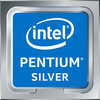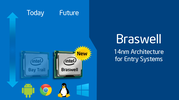Intel Pentium Silver N5030 vs Intel Celeron N3150
Intel Pentium Silver N5030
► remove from comparison
The Intel Pentium Silver N5030 is a quad-core SoC primarily for inexpensive notebooks and was announced late 2019. It runs at 1.1-3.1 GHz (Single Core Burst) and is based on the Gemini Lake platform. The 5030 is the refresh of the older Pentium 5000 and offers a 400 MHz higher Boost clock. Similar to the Apollo Lake predecessor, the chip is manufactured in a 14 nm process with FinFETs but offers slightly improved processor cores, double the amount of L2 cache, a smaller package, a better GPU architecture and a partly integrated WiFi support. Besides four CPU cores, the chip also includes a DirectX 12 capable GPU as well as a DDR4/LPDDR4 memory controller (dual-channel, up to 2400 MHz). The SoC is not replaceable as it is directly soldered to the mainboard.
Architecture
The processor architecture is still called Goldmont Plus. Compared to the older Goldmont cores in Apollo Lake, they feature an increased level 2 cache (to 4 MB). That means the per-clock-performance should be a bit better, but not near the Core CPUs like Kaby Lake Y.
Performance
The average N5030 in our database proves unable to beat the AMD 3020e, an entry-level dual-core CPU of similar power efficiency, in multi-thread performance, rendering the Pentium a poor option for anything but the most basic day-to-day activities, as of late 2022.
GPU Performance
The UHD Graphics 605 (Gemini Lake) is based on Intel's Gen9 architecture, which supports DirectX 12 and is also used for the Kaby Lake / Skylake / Apollo Lake graphics adapters (like HD Graphics 520). Equipped with 18 EUs and a clock of up to 750 MHz, the performance should be roughly on par with the older HD Graphics 5300 and HD Graphics 505 (Apollo Lake).
The chip also includes an advanced video engine with hardware support for the playback of VP9 and H.265 material (8-bit color-depth).
Power consumption
Like most N-class Intel chips, the Pentium has a default TDP, also known as the long-term power limit, of 6 W. This is low and thus good enough for passively cooled tablets, laptops, mini-PCs and handhelds.
The Intel Pentium N5030 is built with one of the old 14 nm Intel processes making for poor, as of early 2023, energy efficiency.
Intel Celeron N3150
► remove from comparison
The Intel Celeron N3150 is a quad-core SoC for entry-level notebooks, which has been presented in early 2015. It is clocked at 1.6 - 2.08 GHz and part of the Braswell platform. Thanks to its new 14 nanometer low-power process (P1273) with tri-gate transistors, energy efficiency has been significantly improved compared to its predecessor Bay Trail (e.g. Celeron N2930). In addition to the CPU cores, the SoC offers a DirectX 11.2-capable GPU as well as a DDR3L Memory Controller (2x 64 bit, 25.6 GB/s).
Architecture
The processor cores are based on the Airmont architecture, which is basically a slightly modified shrink of the previous Silvermont core. While performance per clock has not been improved, the more efficient 14 nm process may lead to a better utilization of the CPU Burst (alias Turbo Boost) and therefore a somewhat higher performance in certain situations.
Performance
Compared to its predecessor Celeron N2930 (1.8 - 2.2 GHz) or the competing AMD APU E2-6110, the N3150 offers an almost identical performance. Using Windows, the CPU is adequate for everyday tasks such as Internet browsing or office applications, but may struggle in more demanding software.
Graphics
The HD Graphics (Braswell) is based on the Intel Gen8 architecture, which supports DirectX 11.2 and is also found in the Broadwell series (e.g. HD Graphics 5300). With 12 EUs (Execution Units) and a clock speed of up to 640 MHz, the GPU is almost twice as fast as the HD Graphics (Bay Trail), but still not powerful enough to handle demanding 3D games of 2015. The GPU also supports 4K/H.265 video acceleration.
Power Consumption
The entire SoC is rated at an TDP of 6 watts (SDP 4 watts). Thus, the chip can be cooled passively.
| Model | Intel Pentium Silver N5030 | Intel Celeron N3150 | ||||||||||||||||||||||||||||||||||||||||||||
| Codename | Gemini Lake Refresh | Braswell | ||||||||||||||||||||||||||||||||||||||||||||
| Series | Intel Gemini Lake | Intel Celeron | ||||||||||||||||||||||||||||||||||||||||||||
| Series: Celeron Braswell |
|
| ||||||||||||||||||||||||||||||||||||||||||||
| Clock | 1100 - 3100 MHz | 1600 - 2080 MHz | ||||||||||||||||||||||||||||||||||||||||||||
| L2 Cache | 4 MB | 2 MB | ||||||||||||||||||||||||||||||||||||||||||||
| Cores / Threads | 4 / 4 | 4 / 4 | ||||||||||||||||||||||||||||||||||||||||||||
| TDP | 6 Watt | 6 Watt | ||||||||||||||||||||||||||||||||||||||||||||
| Technology | 14 nm | 14 nm | ||||||||||||||||||||||||||||||||||||||||||||
| max. Temp. | 105 °C | 90 °C | ||||||||||||||||||||||||||||||||||||||||||||
| Socket | BGA1090 | FCBGA1170 | ||||||||||||||||||||||||||||||||||||||||||||
| Features | DDR4-2400/LPDDR4-2400 RAM, PCIe 2, MMX, SSE, SSE2, SSE3, SSSE3, SSE4.1, SSE4.2, VMX, SMEP, SMAP, MPX, EIST, TM1, TM2, Turbo, AES-NI, RDRAND, RDSEED, SHA, SGX | Intel HD Graphics (Braswell, 12 EUs, 320 - 640 MHz), Wireless Display, Quick Sync, AES-NI, max. 8 GB Dual-Channel DDR3L-1600 (25,6 GB/s), 5x USB 3.0, 4x PCIe 2.0, 2x SATA 6.0 Gbit/s | ||||||||||||||||||||||||||||||||||||||||||||
| iGPU | Intel UHD Graphics 605 (200 - 750 MHz) | Intel HD Graphics (Braswell) (320 - 640 MHz) | ||||||||||||||||||||||||||||||||||||||||||||
| Architecture | x86 | x86 | ||||||||||||||||||||||||||||||||||||||||||||
| Announced | ||||||||||||||||||||||||||||||||||||||||||||||
| Manufacturer | ark.intel.com | ark.intel.com | ||||||||||||||||||||||||||||||||||||||||||||
| $107 U.S. |
Benchmarks
Average Benchmarks Intel Pentium Silver N5030 → 100% n=22
Average Benchmarks Intel Celeron N3150 → 54% n=22
* Smaller numbers mean a higher performance
1 This benchmark is not used for the average calculation












